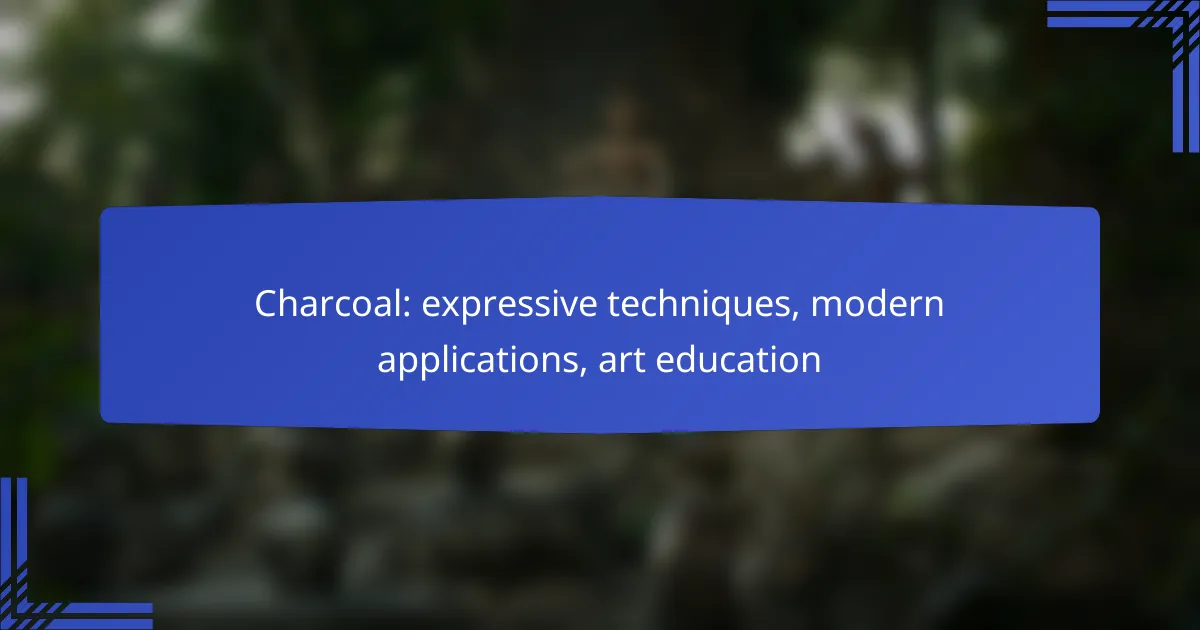Charcoal is a versatile medium in modern art, celebrated for its expressive capabilities and ability to create a wide range of textures. In art education, it serves as an effective tool for fostering creativity and developing technical skills, allowing students to explore various techniques affordably. Mastering charcoal involves selecting the appropriate type, honing blending and shading skills, and ensuring proper preservation of artworks to enhance their quality and longevity.
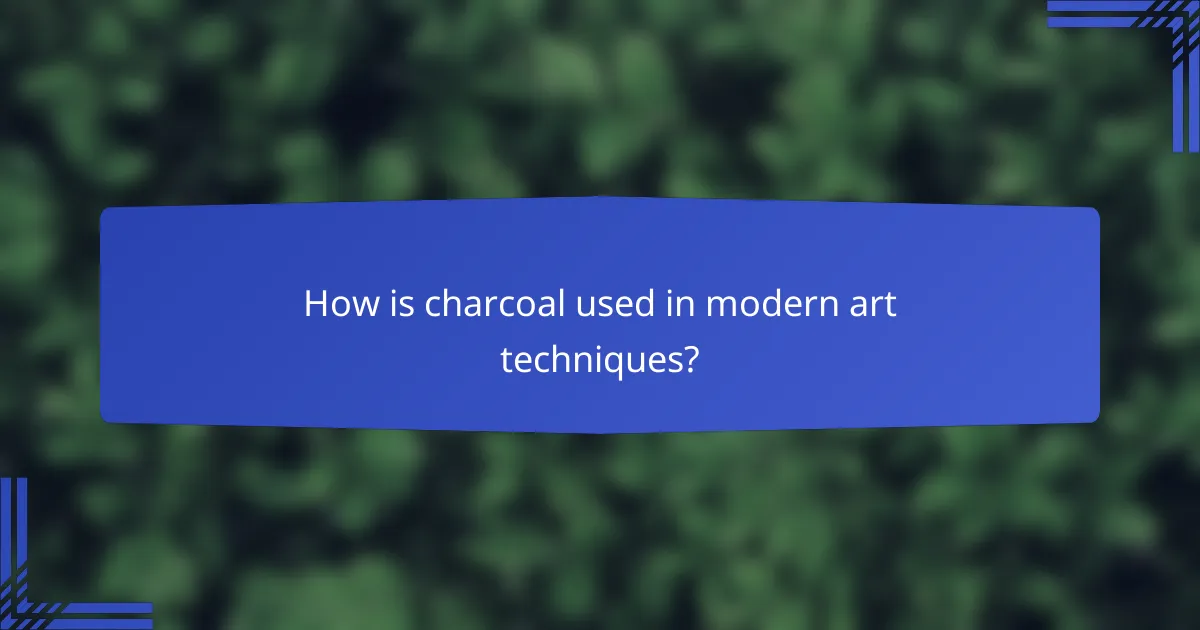
How is charcoal used in modern art techniques?
Charcoal is widely utilized in modern art techniques for its versatility and expressive potential. Artists employ charcoal for drawing, shading, and even mixed media applications, allowing for a range of textures and effects that enhance their work.
Expressive drawing methods
Expressive drawing methods using charcoal often focus on its ability to create bold lines and deep contrasts. Artists can manipulate the medium to achieve varying degrees of intensity, from soft, delicate strokes to heavy, dramatic marks. Techniques such as smudging and layering allow for rich textures and dynamic compositions.
Common approaches include gesture drawing, where quick, fluid motions capture the essence of a subject, and contour drawing, which emphasizes outlines and shapes. Both methods benefit from charcoal’s forgiving nature, enabling corrections and adjustments with ease.
Mixed media applications
In mixed media applications, charcoal pairs well with other materials like ink, watercolor, and pastels. This combination enhances depth and complexity in artwork, allowing artists to explore different visual effects. For instance, charcoal can provide a strong foundation for watercolor washes, creating striking contrasts.
When using mixed media, artists should consider the layering order; applying charcoal first can establish a base, while lighter media can be added on top. This approach not only enriches the visual narrative but also invites experimentation with various textures and finishes.
Charcoal in contemporary installations
Charcoal has found its place in contemporary installations, where it serves as both a medium and a conceptual element. Artists often use large-scale charcoal drawings or sculptures to engage viewers and provoke thought about themes such as impermanence and transformation. The ephemeral quality of charcoal allows for unique interactions within the installation space.
In these settings, charcoal can be utilized in innovative ways, such as creating temporary murals or interactive pieces that change over time. This adaptability makes charcoal a powerful tool for contemporary artists seeking to challenge traditional boundaries and engage audiences in new ways.

What are the benefits of using charcoal in art education?
Using charcoal in art education offers numerous benefits, including fostering creativity and enhancing technical skills. Its unique properties allow students to experiment with various techniques while maintaining an affordable approach to art materials.
Enhances creativity and expression
Charcoal encourages artists to explore their creative potential through its versatile application. The medium allows for a range of expressive techniques, from soft shading to bold lines, enabling students to convey emotions and ideas effectively.
By using charcoal, learners can easily manipulate the material, resulting in spontaneous and dynamic artworks. This flexibility promotes experimentation, which is crucial for developing a personal artistic voice.
Improves technical skills
Working with charcoal helps students refine their drawing techniques, such as line control, shading, and perspective. The medium’s forgiving nature allows for easy corrections, encouraging practice and improvement without the fear of making permanent mistakes.
As students gain confidence in their abilities, they can tackle more complex subjects and compositions. Regular use of charcoal can lead to significant advancements in overall drawing proficiency.
Accessible and affordable medium
Charcoal is one of the most accessible art materials, available in various forms such as sticks, pencils, and compressed blocks. This variety caters to different preferences and techniques, making it suitable for all skill levels.
In terms of cost, charcoal is relatively inexpensive compared to other art supplies, making it an ideal choice for educational settings. Many schools and art programs can easily incorporate charcoal into their curricula without straining budgets.
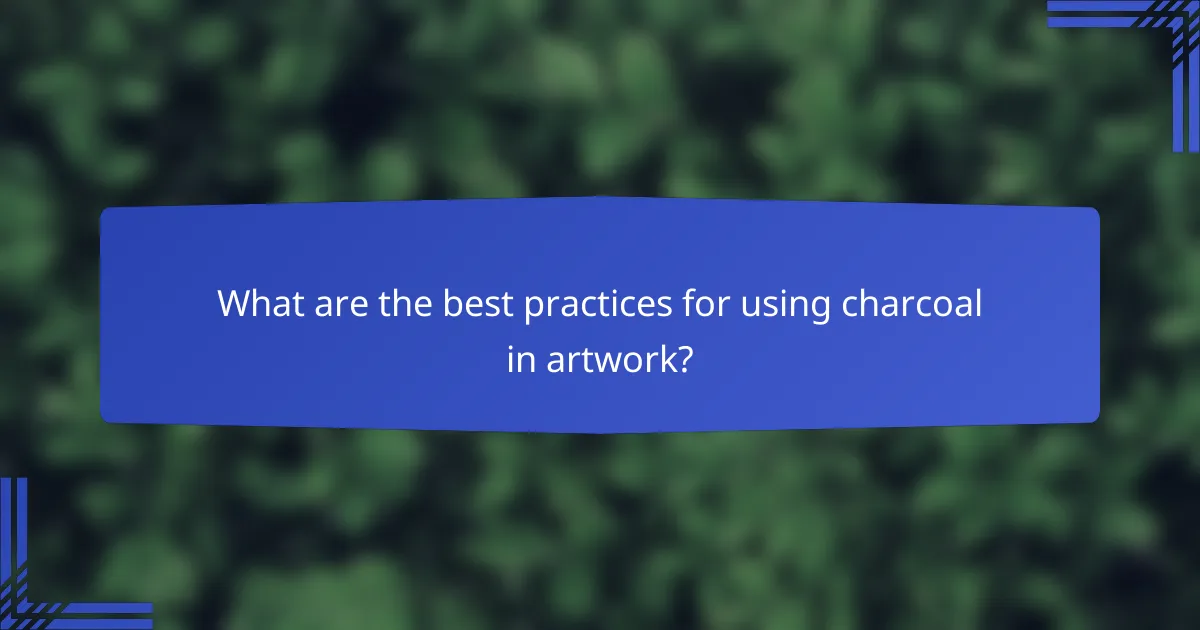
What are the best practices for using charcoal in artwork?
To effectively use charcoal in artwork, artists should focus on selecting the right type of charcoal, mastering blending and shading techniques, and ensuring proper preservation of their finished pieces. These practices enhance the quality and longevity of charcoal drawings.
Choosing the right type of charcoal
Selecting the appropriate type of charcoal is crucial for achieving desired effects. There are three main types: vine charcoal, compressed charcoal, and charcoal pencils. Vine charcoal is soft and easy to erase, making it ideal for sketching, while compressed charcoal offers darker, more intense lines suitable for finished pieces.
Artists should consider the texture and weight of the paper when choosing charcoal. Heavier papers can handle more pressure and layering, while lighter papers may require softer charcoal to avoid tearing.
Techniques for blending and shading
Blending and shading techniques greatly influence the depth and realism of charcoal artwork. Using tools like blending stumps, fingers, or soft cloths can help create smooth transitions between light and dark areas. It’s essential to practice varying pressure to achieve different shades.
Another effective method is layering, where artists build up tones gradually. Start with lighter layers and progressively add darker shades to create dimension. Avoid over-blending, as this can lead to a muddy appearance.
Preserving charcoal artworks
To preserve charcoal artworks, artists should use fixatives to prevent smudging and fading. Spray fixatives are commonly used, but it’s important to apply them in light layers to avoid altering the artwork’s appearance. Always work in a well-ventilated area when using fixatives.
Additionally, storing charcoal drawings flat and away from direct sunlight can help maintain their quality. Using protective sheets or frames can further shield the artwork from dust and damage, ensuring its longevity.
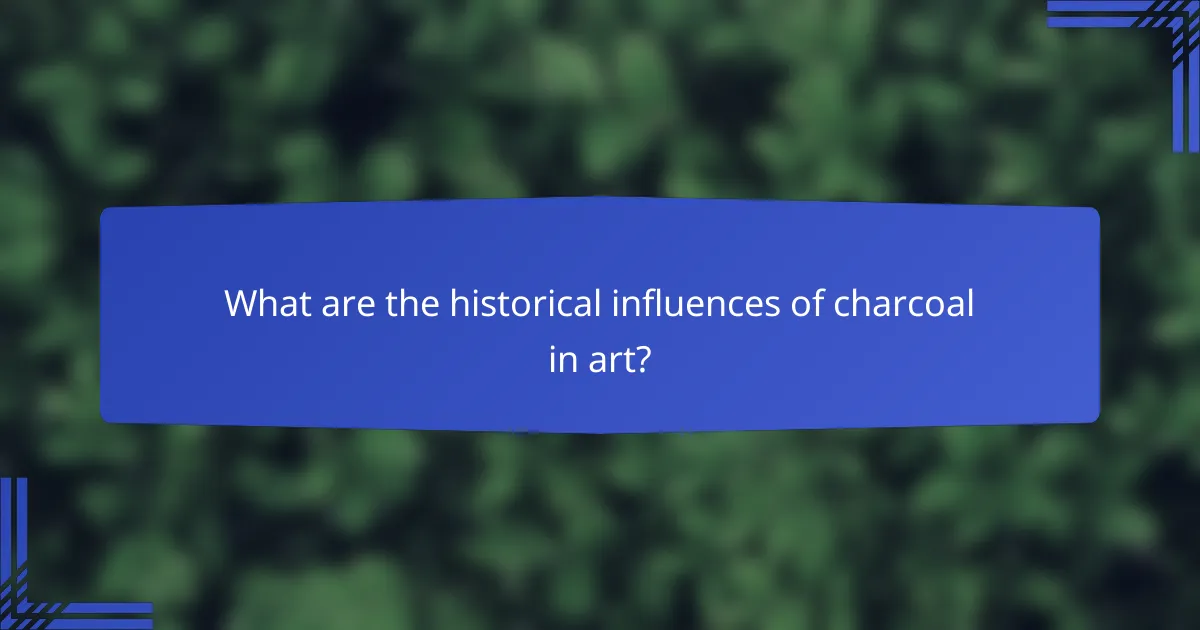
What are the historical influences of charcoal in art?
Charcoal has played a significant role in the evolution of art, serving as a versatile medium for drawing and sketching throughout history. Its rich tonal range and ease of use have made it a favored choice among artists from various periods, influencing techniques and styles.
Renaissance artists and charcoal
During the Renaissance, artists utilized charcoal for preliminary sketches and studies, allowing them to explore composition and form before committing to more permanent mediums. Notable figures like Leonardo da Vinci and Michelangelo often employed charcoal to create detailed studies of anatomy and perspective, which laid the groundwork for their masterpieces.
Charcoal’s ability to produce both fine lines and broad strokes enabled Renaissance artists to experiment with light and shadow, enhancing the three-dimensionality of their work. This flexibility made it an essential tool in the development of techniques such as chiaroscuro, which emphasized contrast and depth.
Charcoal in 19th-century art movements
The 19th century saw a resurgence of charcoal use, particularly among artists associated with Romanticism and Impressionism. Artists like Eugène Delacroix and Edgar Degas favored charcoal for its expressive qualities, allowing them to capture movement and emotion in their works.
Charcoal became integral to the development of new artistic styles, as it enabled rapid sketching and experimentation. This was particularly useful for plein air painters, who sought to capture the fleeting effects of light and atmosphere in their landscapes. The medium’s immediacy and versatility encouraged artists to push boundaries, leading to innovative approaches that influenced modern art.
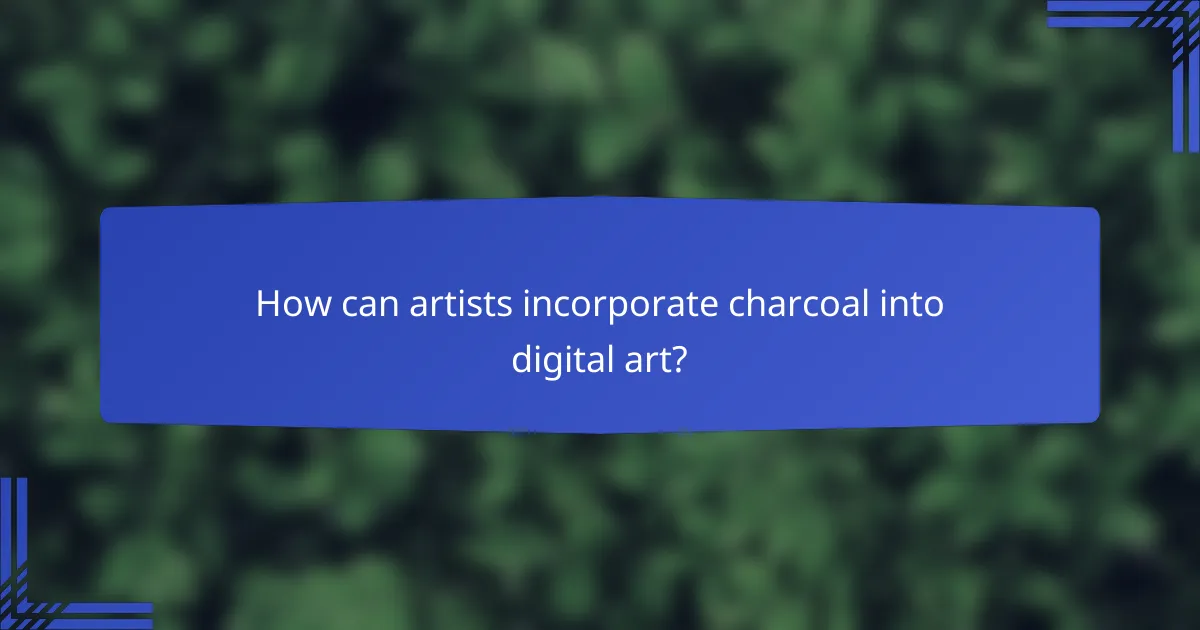
How can artists incorporate charcoal into digital art?
Artists can effectively incorporate charcoal into digital art by scanning or photographing their charcoal drawings and then using software to enhance or manipulate these images. This blend of traditional and digital techniques allows for greater creativity and flexibility in the artistic process.
Digitizing charcoal drawings
To digitize charcoal drawings, artists should start by ensuring good lighting and a high-resolution scan or photograph of their artwork. Using a flatbed scanner is ideal for capturing details, while a camera can be useful for larger pieces. After digitization, artists can adjust brightness and contrast to enhance the visibility of the charcoal texture.
It’s important to save the digital files in formats like PNG or TIFF to preserve quality. Artists should also consider organizing their files systematically, perhaps by date or project, to streamline future editing and access.
Combining charcoal with digital tools
Combining charcoal with digital tools involves using graphic design software to manipulate the digitized charcoal images. Programs like Adobe Photoshop or Procreate allow artists to layer, blend, and add colors, creating unique compositions that maintain the organic feel of charcoal.
Artists can experiment with brushes that mimic charcoal textures in digital formats, allowing for a seamless integration of traditional and modern techniques. It’s beneficial to familiarize oneself with the software’s features, such as layering and masking, to maximize creative potential.

What are emerging trends in charcoal art?
Emerging trends in charcoal art focus on innovative techniques and modern applications that enhance expressiveness and versatility. Artists are increasingly blending charcoal with other mediums and exploring digital platforms to create dynamic works.
Innovative techniques in charcoal drawing
Innovative techniques in charcoal drawing include layering, blending, and using unconventional tools. Artists often combine charcoal with materials like pastels or ink to create depth and texture, allowing for more expressive outcomes. Techniques such as smudging with fingers or cloth can produce soft transitions and rich tonal variations.
Integration of charcoal with mixed media
Integrating charcoal with mixed media has gained popularity, as artists seek to push the boundaries of traditional charcoal art. This approach allows for the combination of textures and colors, enhancing visual interest. For example, charcoal can be paired with acrylics or watercolors to create striking contrasts and unique compositions.
Charcoal art in digital platforms
Digital platforms are becoming a significant avenue for charcoal art, enabling artists to create and share their work online. Software tools mimic the texture and feel of charcoal, allowing for experimentation without the mess. This trend opens up new possibilities for collaboration and exposure, as artists can reach a global audience through social media and online galleries.
